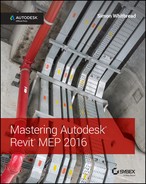Book Description
Get up and running on Autodesk Revit MEP 2016 with this detailed, hands-on guide
Mastering Autodesk Revit MEP 2016 provides perfectly paced coverage of all core concepts and functionality, with tips, tricks, and hands-on exercises that help you optimize productivity. With a focus on real-world uses and workflows, this detailed reference explains Revit MEP tools and functionality in the context of professional design and provides the practical insight that can only come from years of experience. Coverage includes project setup, work sharing, building loads, ductwork, electrical and plumbing, and much more, with clear explanation every step of the way. The companion website features downloadable tutorials that reinforce the material presented, allowing you to jump in at any point and compare your work to the pros.
This is your guide to master the capabilities of this essential productivity-enhancing tool.
Generate schedules that show quantities, materials, design dependencies, and more
Evaluate building loads, and design logical air, water, and fire protection systems
Create comprehensive electrical and plumbing plans tailored to the project
Model your design with custom parameters, symbols, fixtures, devices, and more
If you're ready to get on board this emerging design, collaboration, and documentation paradigm, Mastering Autodesk Revit MEP 2016 is the one-stop resource you need.
